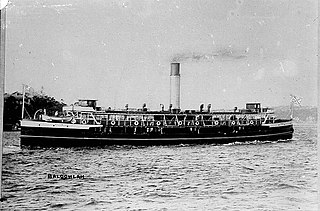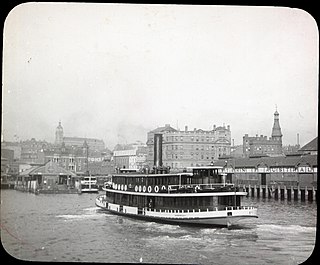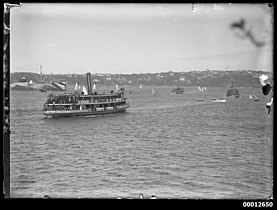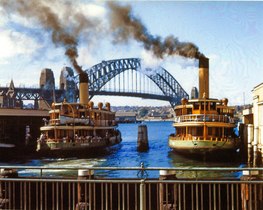
HMAS Kuttabul, formerly SS Kuttabul, was a Royal Australian Navy depot ship, converted from a Sydney Ferries Limited ferry.

The Dee Why and Curl Curl, were two identical steam ferries servicing Sydney Harbour's Circular Quay to Manly service. Both commissioned in 1928, they were the largest ferries on Sydney Harbour until the 1938 introduction of the South Steyne.

SS Balgowlah was a ferry on Sydney Harbour operated by the Port Jackson & Manly Steamship Company on the Manly service from 1912 until 1951.

Koompartoo was a 1922 Sydney Ferries Limited K-class ferry later converted to a Royal Australian Navy boom defence vessel. Koompartoo, described in the press as a "Dreadnought for the Milsons Point run" and "a titan amongst ferries", was along with her sister ferry, Kuttabul, the highest capacity ferries ever on Sydney Harbour.
Sydney Ferries Limited operated ferry services on Sydney Harbour from 1900 until June 1951.

The MV North Head was a ferry operated by the Port Jackson & Manly Steamship Company and its successors on the Manly service from 1913 until 1985.

Kirawa was a ferry on Sydney Harbour. She was a near identical sister vessel with Kanangra both of which were launched in 1912 during the early-twentieth pre-Sydney Harbour Bridge boom years of Sydney Ferries Limited.

Koree was a "K-class" ferry on Sydney Harbour. Launched in 1902, the timber-hulled steamer was built for Sydney Ferries Limited during the boom in cross-harbour ferry travel prior to the opening of the Sydney Harbour Bridge.

Kulgoa was a "K-class" ferry on Sydney Harbour. Launched in 1905, the timber-hulled steamer was built for Sydney Ferries Limited during the boom in cross-harbour ferry travel prior to the 1932 opening of the Sydney Harbour Bridge. Kulgoa was Sydney's largest ever wooden ferry. She was a typical early example of the "K-class"; a group of double-deck, double-ended, steam-powered screw ferries. Kulgoa was one of the first Sydney ferries built with the sides of her promenade (upper) deck enclosed, although the ends near the wheelhouses remained open.

Binngarra was a ferry operated by Port Jackson & Manly Steamship Company on the Manly service. Launched in 1905, she was the first of six similar vessels built for the company–the Binngarra class—the success of which saw three of her sister vessels serving through to the 1970s and 1980s.

Kameruka and Kamiri were near identical ferries that served on Sydney Harbour. Kamiri was built in 1912 and Kameruka was launched on 8 February 1913. They were double-ended "K-class" steam ferries, a type that was prolific on Sydney Harbour in the early 20th century boom in cross-Sydney Harbour ferry transport before the 1932 opening of the Sydney Harbour Bridge. Kamiri was laid up in 1951 following the New South Wales government take-over of the Sydney Ferries Limited. Kameruka was converted to diesel in 1954 and was laid up in 1984.

Kanimbla was a "K-class" ferry on Sydney Harbour. Launched in 1910, the timber-hulled steamer was built for Sydney Ferries Limited during the boom in cross-harbour ferry travel prior to the opening of the Sydney Harbour Bridge. Kanimbla was renamed "Kurra-Ba" in 1935. She was laid up in the 1940s and broken up in the 1950s.

Lady Scott, later John Cadman and Harbour Queen, was a Sydney Harbour ferry built in 1914 for the Balmain New Ferry Company. She and four similar ferries, Lady Chelmsford (1910), Lady Denman (1912), Lady Edeline (1913), and Lady Ferguson (1914), were a new series of "Lady-class", designed by renowned naval architect, Walter Reeks.

Kareela was a "K-class" ferry on Sydney Harbour. Launched in 1905, the double-ended timber-hulled steamer was built for Sydney Ferries Limited in response to the early twentieth century boom in cross-harbour ferry travel prior to the opening of the Sydney Harbour Bridge. She was the first of Sydney Ferries Limited's boats to have a fully enclosed upper deck.

Kosciusko was a "K-class" ferry on Sydney Harbour. Launched in 1911, the timber-hulled steamer was built for Sydney Ferries Limited during the boom in cross-harbour ferry travel prior to the opening of the Sydney Harbour Bridge.

Sydney Harbour ferry services date back to the first years of Sydney's European settlement. Slow and sporadic boats ran along the Parramatta River from Sydney to Parramatta and served the agricultural settlements in between. By the mid-1830s, speculative ventures established regular services. From the late-nineteenth century the North Shore developed rapidly. A rail connection to Milsons Point took alighting ferry passengers up the North Shore line to Hornsby, New South Wales via North Sydney. Without a bridge connection, increasingly large fleets of steamers serviced the cross harbour routes and in the early twentieth century, Sydney Ferries Limited was the largest ferry operator in the world.

Kookooburra was a "K-class" ferry on Sydney Harbour. Commissioned in 1907, the timber-hulled steamer was built for Sydney Ferries Limited during the boom in cross-harbour ferry travel prior to the opening of the Sydney Harbour Bridge. She was retired from Sydney Harbour service in 1947 after which she was sent to Newcastle. She is thought to have been broken up in 1959.

Kurraba and Kirribilli were two similar "K-class" ferries on Sydney Harbour. Launched in 1899 and 1900 respectively, the two timber-hulled steamers were built for Sydney Ferries Limited during the boom in cross-harbour ferry travel prior to the opening of the Sydney Harbour Bridge.

Karingal was a ferry operated by Sydney Ferries Limited and its NSW State Government operated successors on Sydney Harbour from 1913 until 1984. A wooden ferry built at the time of Sydney Ferries' rapid early twentieth century, she was the smallest of the round-end "K-class ferries".

Kanangra is a retired ferry on Sydney Harbour. She was launched in 1912 during the early-twentieth century pre-Sydney Harbour Bridge boom years of Sydney Ferries Limited.
































